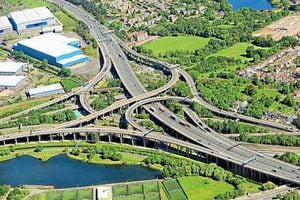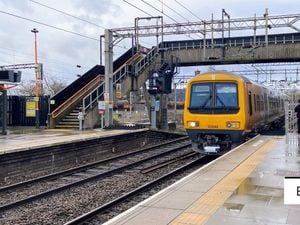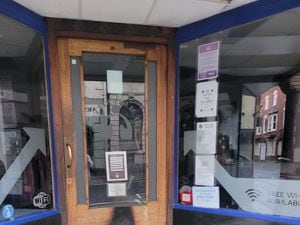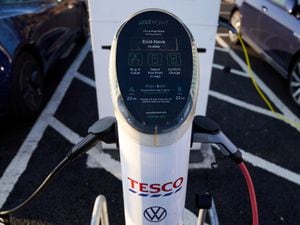Secret history of Spaghetti Junction
[gallery] As Spaghetti Junction celebrates its 40th birthday, Mark Andrews discovers the secret world underneath it.

As Spaghetti Junction celebrates its 40th birthday,
discovers the secret world underneath it.
A pair of Canadian geese peck away at the undergrowth, as the Rivers Rea and Tame flow gently by.
Like purple paintbrushes, the wild lupins poke their heads above the yellow forest of yellow daisies sprouting up on the river bank.
Click on the image to the right for more photographs
You would never guess you were beneath one of Europe's largest motorway junctions.
The Gravelly Hill Interchange, or Spaghetti Junction as it is better known, is 40 years old this week.
When Environment Minister Peter Walker opened the new intersection on May 24, 1972, he described it as the "most exciting day in the history of the road system in this country."
The Express & Star was a little more succinct. "Magnificent Seven Miles" was the headline. Immediately it was besieged by motorists wanting to experience a exciting new chapter in motoring history. Coach operators offered sightseeing tours at 65p a head.
Forty years on, 210,000 vehicles rumble along this complicated labyrinth of steel and concrete every day.
It serves 18 different routes, and you would have to drive 73 miles to travel the entire junction – even though it covers less than a mile of the M6.
But how many of the people who pass through the myriad of motorways, sliproads and flyovers, have any idea of the fascinating world that lies beneath?
The junction covers 30 acres of ground, a site which also takes in two railway lines, three canals, and two rivers.
Popular
In an unusual meeting of old and new forms of transport, the pillars supporting the flyovers across the Birmingham Canal had to be carefully placed to enable a horse-drawn canal boat to pass beneath, without fouling the tow rope.
Today it is still a popular route with narrowboat fans, although the boats are more likely to be diesel rather than horse-powered.
Boarding a boat near Salford canal junction, in the shadow of Spaghetti's giant concrete columns, are Adrian Rowland, from Durham, and Kate Nye from Penrith in Cumbria.
"We're on a week's holiday and just thought we would have a look around," says 24-year-old Kate. "It's good to be able to see the structure holding it all up," says Adrian, who is 26.
The junction's popularity with the rambling fraternity is easy to understand when you explore the contrasting sights and sounds beneath this thrumming artery of Britain's motorway network, it is very easy to see why.
Standing on the pebbled banks where the River Rea meets the River Tame, you can feel the gentle vibrations in the giant concrete stilts supporting the road above.
The geese milling about the tranquil looking river banks seem blissfully unfazed by the clatter of the traffic above, or the factories on the other side of the water. And some of the structures, although designed first and foremost for practicality, nevertheless have a beauty of their own.
The sandy coloured Salford Turnover Bridge is a beautiful piece of civil engineering which has been marred by the mindlessness of graffiti offenders – and a strange fly poster written entirely in Russian.
At the end of one of the canal tunnels is an opening supported by 13 columns, which in another environment would resemble a Roman collonade.
The wonderland beneath Spaghetti Junction did not happen by accident, though. Rather it was the result of a most ingenious engineering solution to the challenges of constructing such a large development in the heart of one of Europe's biggest conurbations.
When the plans were unveiled in the late 1960s, transport minister Stephen Swingler said driving motorways through the built-up areas of the West Midlands would cost between £2 million and £3m a mile, compared to £750,000 in rural areas.
But while a peripheral route around the edge of the conurbation would save money and reduce disruption, it would also mean longer roads and greater journey times.
The answer was to build the road on stilts above existing canals and railway lines, which meant it was possible to create a short, direct route through the urban heartlands without the need for widescale demolition. Today it is easy to forget just how the construction of this vital road junction transformed motoring in Britain.
It meant for the first time it was possible to travel from London to Glasgow along a continuous 300-mile stretch of motorway. In one day, Britain went from having a fragmented network of roads to a seamless motorway network connecting all its great cities.
Ribbon
The story began when Prime Minister Harold Macmillan cut the ribbon on the Preston Bypass in 1958, the first phase of a plan to create a national network of three high speed "motorways".
The Preston Bypass would become the M6, eventually extending to Birmingham in the south and Glasgow in the north. A second motorway, the M1, would run from London to Yorkshire, while the M5 would link Birmingham to South Wales.
These certainly made journey times quicker, but they were still very regional in their nature, serving specific parts of the UK.
But when Spaghetti Junction opened in 1972, it finally brought them all together, transforming a set of three separate routes into a single integrated network.
It meant people could make seamless journeys across the country without ever leaving the motorway.
Actually, there was a little more to it than that. Spaghetti Junction – the Express & Star had adopted this nickname before it had actually opened – was one part of the complex 64-mile Midland Links project to bring the motorways together.
But as the final piece in the jigsaw, and with its unique multi-level design, it was always going to be Spaghetti that attracted the headlines.
The junction was so strategic to the nation's infrastructure, that it was said to have been a nuclear target by the Soviet Union during the Cold War.
The final scheme was unveiled by Transport Secretary Barbara Castle in June, 1968, and the work began shortly after.
Construction was expected to take three years, and cost £8 million – in the end it took closer to four years, and cost £10.8m – £120m in today's money. The opening of the junction was delayed by a few months following the collapse of bridges using similar "box girder" construction in Australia and Wales. When the junction was opened it was designed to last 120 years, although it has required major repair work on several occasions since opening.
Scaffolding
Anybody venturing beneath the junction today will notice the scaffolding of construction workers who are carrying out vital maintenance work. In November 2007, a sliproad running from the Tyburn Road onto the Aston Expressway was closed for urgent repairs after salt and grit had weakened the joints in the structure.
Perhaps that is not too surprising. It was designed to be able to carry 75,000 vehicles a day, and in 1972 the actual figure was just over half that.
Today the number has risen to around 210,000 a day, and it is estimated that more than 2 billion vehicles will have passed through the junction over the last 40 years. Approximately 5 million tons of freight passes through the junction every week.
"Every time a lorry puts on its brakes, it piles pressure on the supports from down here," says Andy Butterfield, construction manager with the Highways Agency.
He says we will not see its like again.
"We would never build another like this, the layout would be very different now," says Andy. From ground level looking up at it you realise what an amazing feat of engineering it really is. To me it's a thing of beauty."
Spaghetti Junction - 40 facts:
1) Spaghetti Junction marks its 40th birthday on May 24.
2) Its official name is the Gravelly Hill Interchange. But the Express & Star was already referring to it as "Spaghetti Junction" the year before it opened.
3) It was the centrepiece of the Midland Links project, to join up the M1, M5, M6 motorways and the A38(M) Aston Expressway to bring traffic into the heart of Birmingham.
4 )The designers had to build a six-lane carriageway and link roads through several built-up areas, with the minimum demolition and disruption. To achieve this, the M6 and the junction follow the line of the canal and river network on elevated sections.
5) In an interesting meeting of old and new methods of transport, the pillars carrying the interchange over the canal network had to be carefully placed to allow a horse-drawn narrow boat to pass underneath without fouling its tow rope.
6) Construction started in 1968 and took four years to complete.
7) It has 559 concrete columns, some reaching to 80 feet high.
8) The first motorists used it on May 24, 1972 at approximately 4.30pm.
9) It was opened by then Secretary of State for the Environment, the Rt Honourable Peter Walker MBE MP.
10) To celebrate the opening of a non-stop link between the North West and the South East, the Lord Mayor of Lancaster Councillor Mrs Doris Henderson, presented a red rose to Peter Walker to wear for the opening ceremony. In return, the Lord Mayor of London, Lord Mais, sent a bouquet of 243 roses to Councillor Henderson; one for each mile between Mansion House in London and Lancaster Town Hall.
11) The junction is woven into the vestments of the clergy at Birmingham Cathedral. It was also used in the opening credits of the short-lived Midlands soap opera Family Pride.
12) Gravelly Hill Interchange cost £10.8 million to build at the time.
13) Construction involved 13,000 tons of steel reinforcement.
14 )It used 175,000 cubic yards of concrete.
15) The Junction covers 30 acres.
16) 18 routes are served by the junction which links the M6 to the A38M Aston Expressway, the A5127 Gravelly Hill and the A38 Tyburn Road
17) It includes 2.5 miles of slip roads, but only 0.62 miles of the M6 itself.
18) Cliff Richard sped below it on a hovercraft in 1973 film Take Me High.
19) The junction is designed to last 120 years.
20) Routine repairs to the reinforced concrete structures have been ongoing since the late 1980s.
21) Regular maintenance includes the replacement of expansion joints, painting of steelwork, the clearing drainage channels and gutters, clearance of vegetation and removal of graffiti.
22) Concrete repairs are carried out in small sections, so the overall strength of the supporting beams is never compromised.
23) During concrete repairs, small sections of old concrete are cut out using water. That's right. Specially trained operatives use a lance to carefully guide a jet of water, pressurised at 16,000 psi, which cuts through concrete with surgical ease. Using water rather than physical tools removes the risk of damage to other sections of viaduct through vibration.
24) As work is carried out beneath the main carriageway, drivers would never be aware that work is being carried out beneath them.
25) In 1998 Birmingham Cathedral had a new set of vestments designed which included Spaghetti Junction as seen from the air.
26) 'Spaghetti Junction' has its own entry in the Oxford English Dictionary but you will never find that name on a road map; it is also referred to as Gravelly Hill Interchange on ordnance survey road maps.
27) Birmingham historian Vivian Bird, writing in 1974, referred to Spaghetti Junction as an act of 'plandalism', calling it the Gravelly Hill earthquake and a wall that imprisoned the people of Birmingham.
28) Spaghetti Junction appears in the Guinness Book of World Records, as "the most complex interchange on the British road system".
29) Diamond' road markings were first piloted on the M6 at Spaghetti Junction in 1999 to improve safety by warning against last minute lane changing or 'swooping'.
30) The Highways Agency is preparing for the installation of a system known as 'Managed Motorways' through Spaghetti Junction, which will allow hard shoulder running and variable speed limits to keep traffic flowing.
31) On average, Highways Agency Traffic officers attend approximately 20 incidents at Gravelly Hill Interchange per week. This can range from vehicle breakdowns right through to issues of a more serious nature, which are rare.
32) Spaghetti Junction has 46 signals, 3 electronic message signs and 25 emergency roadside telephones.
33) It also has its own weather station to monitor conditions.
34) Spaghetti Junction is one of the biggest motorway interchanges in Europe, and one of the most recognisable.
35) If you wanted to drive along every road at Junction itself, adhering to the Highway Code, you would have to travel approximately 73 miles.
36) Construction of the Junction meant having to divert the River Tame and the reduction in size of a lake nearby. As the lake is registered as a reservoir under the Reservoirs Act, the construction of the bund between the river channel and the lake had to be supervised by an engineer on the register of Dam Engineers.
37) Highways Agency spends approximately £7 million a year to maintain Spaghetti Junction in a safe and serviceable condition.
38) It has embedded itself so deeply in local culture that even the Birmingham City University Student Union has named their official magazine after it.
39) During the first year of opening, the average flow of vehicles was 40,000 per day. Today, the average daily flow is over 210,000 vehicles.
40) In its 40-year history, it has carried nearly 2 billion vehicles.





